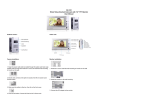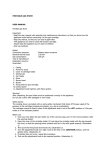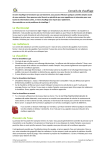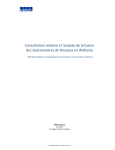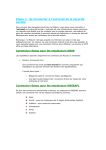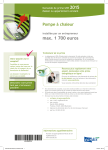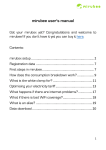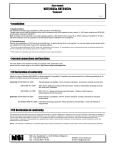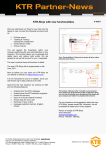Download Heating tips
Transcript
Heating tips If your heating system does not work, you can run a few simple checks before contacting us. This way, we can provide the heating specialist with all the required information to find a quick solution to your problem. Some points to verify: Thermostat Has the thermostat been configured correctly? On the thermostat, temporarily raise the desired temperature and check if the heating system starts up. The thermostat battery may need replacing, or the time displayed may be wrong. If you have a user manual, you can configure the thermostat as required. Replace the battery to eliminate battery problems. Only use alkaline batteries. Do not hesitate to contact us if you notice problems with the thermostat. Radiators Are the radiators open (counter clockwise = opening, clockwise = closing)? Leave the radiator valves open during the summer to avoid them getting stuck. Heating system Gas heating systems Is the gas supply open? Systems with a pilot light, without electronic ignition: has the pilot light gone out? If you have a user manual, you may attempt to light the pilot flame again. Otherwise, please phone us to discuss the best approach. Systems with electronic ignition: if the thermostat activates the system and the electronic ignition can be heard, but the system does not start up, please contact us to discuss the best approach. If you smell gas, please follow the recommendations on the next page! Electric heating systems Verify if there is a problem with the electricity supply to the heating system (a power cut, a problem with the plug or wall socket). Check for any lights on the system, or error messages indicating a specific problem. If you have a user manual, you may attempt to start the system up again. Otherwise, please phone us to discuss the best approach. Fuel heating systems Is there enough fuel in the tank? The website www.calculatorsoup.com/calculators/construction/tank.php helps you calculate the capacity of the tank. If the tank is empty, contact a supplier for a delivery. Most suppliers offer a more advantageous tariff for deliveries of 2000 litres or more. On the burner, there is often an ignition button, which you can press for a few seconds. Once you release the button, the burner should start up. If this does not happen, please contact us to discuss the best approach. Water pressure The water pressure must be 1 to 2 bars. You can usually read the water pressure on the pressure meter near or on the furnace. If the pressure is too low and if you have a user manual, you may attempt to increase the pressure. If not, please contact us to discuss the best approach. It is also possible that excess air must be purged and water must subsequently be added. If this is the case, you will hear a hissing, gurgling sound in the radiators. Usually, only part of the radiator heats, up while other parts remain cold. Once the excess air has been purged, the pressure in the installation must be brought back up to 1 to 2 bar. Please do not hesitate to contact our agency if you need any help. © Ifac Service bvba 2014 This document is offered for information purposes only and does not constitute a contract. Heating tips 1/2 Important details about your heating system Location of the furnace: Brand: Type: Fuel: Supplier or maintenance technician: Specific information: What if you smell gas? source: website of the governmental service ‘Civil security’ (http://www.civieleveiligheid.be) What you must not do Do not light a flame or spark Do not ring the doorbell. It is better to knock on the door Do not switch on any light switches Do not smoke Do not ignite a lighter or light a match Do not use your telephone (fixed line or mobile phone) Do not try to find the leak using a flame What you should do Open doors and windows Deactivate the gas appliance or close the main valve on the gas bottle Inform all inhabitants and leave the building Outside the building, phone the fire department (100) and the grid operator in your region (Eandis, Infrax, usually mentioned on your gas meter) Prevent carbon monoxide intoxication! Carbon monoxide poisoning is caused by the combustion gases of gas water heaters in poorly ventilated rooms or by blocked chimneys. Never skip the mandatory yearly check of heating appliances and chimneys and do not block any vents in rooms with gas installations or fireplaces. More information about the prevention of CO poisoning can be found on our website, in the section Info. More information If you have any questions, please have a look at our website, www.ifacservice.be, section Info, send an email to [email protected] or phone us on 02 767 14 14. © Ifac Service bvba 2014 This document is offered for information purposes only and does not constitute a contract. Heating tips 2/2


